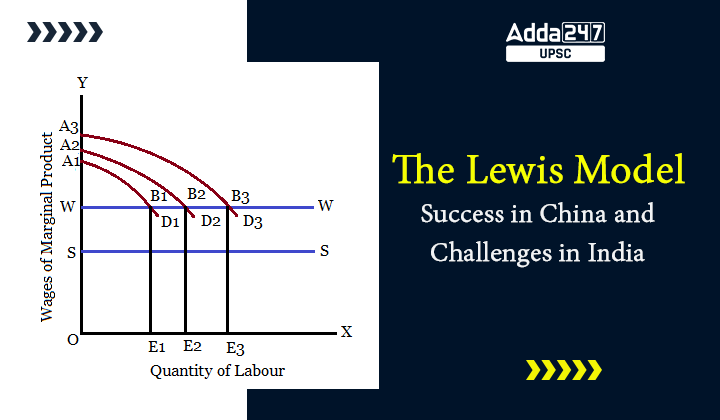Table of Contents
In 1954, Nobel laureate Sir Arthur Lewis proposed a groundbreaking economic theory in his essay “Economic Development with Unlimited Supplies of Labor.” Lewis’s model argued that underdeveloped countries with a surplus of labor could achieve rapid industrialization by transferring workers from agriculture to manufacturing, creating a virtuous cycle of economic growth.
China successfully applied this model, transitioning from a rural, agrarian economy to the “world’s factory.” However, India’s experience with the Lewis Model has been less straightforward, and this article delves into the reasons behind its uneven success.
Lewis Model: A Path to Industrialization
Lewis’s model emphasized the potential of countries with abundant, low-cost labor to fuel industrial growth. It was assumed that a rising capitalist sector could absorb surplus labor from subsistence agriculture, thereby boosting productivity. To achieve this, industries needed to offer wages slightly above subsistence levels, motivating workers to leave the family farm. In this scenario, new industries could proliferate without limits.
The Indian Experience: A Complex Reality
- Despite Lewis’s endorsement of the model for India, the country’s trajectory didn’t match his predictions.
- While the percentage of the workforce engaged in agriculture dropped from 64.6% to 48.9% between 1993–94 and 2011–12, manufacturing’s share in employment only increased marginally, from 10.4% to 12.6% during the same period.
Recent Trends in India’s Labor Market
- Recent years have witnessed fluctuating trends in India’s labor market. The share of the labor force engaged in agriculture declined to 42.5% in 2018–19, then increased to 46.5% in the subsequent years due to COVID-19 disruptions.
- Manufacturing’s share, on the other hand, has seen a decline, dropping to 11.4% in 2022–23. The reversal of the structural transformation described by Lewis is a significant concern for India’s economic prospects.
Labor Movement within Subsistence Sectors
- Economists like Amit Basole at Azim Premji University have highlighted that the labor movement has primarily occurred within subsistence sectors, especially in low-paid services and construction.
- This is in contrast to Lewis’s model, which expected labor to shift to high-productivity manufacturing and services.
The State-Level Perspective
- At the state level, the scenario is not uniform. Manufacturing’s share in employment is often below that of construction and services in states with a high percentage of the workforce engaged in farming.
- Even in states with less reliance on agriculture, the services sector employs two to three times more workers than manufacturing.
- Gujarat stands out as an exception, with a significant proportion of its workforce in manufacturing, resembling the Lewis Model more closely.
The Changing Nature of Manufacturing
- The Lewis Model’s success was largely based on the textile and labor-intensive manufacturing industries of the 1950s.
- However, today, manufacturing has become increasingly capital-intensive, deploying technologies such as robotics, artificial intelligence, and machine learning. This shift has reduced the labor-absorbing capacity of traditional manufacturing industries.
India’s Need for a New Development Model
- Recognizing the evolving economic landscape, NITI Aayog, India’s premier policy think tank, is working on a new development model for the country.
- This model seeks to create remunerative jobs within and around agriculture rather than relying solely on labor migration from agriculture to industry.
- The new approach envisions job opportunities in activities like aggregation, grading, packaging, transportation, processing, warehousing, retailing of produce, or supplying inputs and services to farmers.
China’s Success and India’s Divergent Path
- China’s success with the Lewis Model was due to its ability to leverage its demographic dividend, transforming into the world’s factory.
- However, India is faced with different challenges, including a diminishing scope for employment through traditional industrialization. India’s labor transition must adapt to the changing nature of work and emerging technologies.
Conclusion
The Lewis Model, which advocated labor transfer from agriculture to manufacturing as a path to economic growth, played a crucial role in China’s development. However, India’s experience with this model has been marked by challenges and deviations from the original theory.
The changing nature of manufacturing, coupled with India’s unique demographic and economic realities, necessitates the adoption of a new development model that focuses on creating remunerative jobs within and around agriculture.
As India reevaluates its path to economic growth, it must address the complexities of its labor market and embrace innovative approaches to secure a prosperous future for its workforce.



 TSPSC Group 1 Question Paper 2024, Downl...
TSPSC Group 1 Question Paper 2024, Downl...
 TSPSC Group 1 Answer key 2024 Out, Downl...
TSPSC Group 1 Answer key 2024 Out, Downl...
 UPSC Prelims 2024 Question Paper, Downlo...
UPSC Prelims 2024 Question Paper, Downlo...





